What makes conifers different to other plants?
All conifers, from pine trees to leylandii to yew trees, are within the Division Pinophyta (aka Coniferophyta). The number of species in this division is quite small, approximately 570 (although some estimates are higher), compared to 12,000 in the Bryophyta Division (mosses) or several hundred thousand in the Magnoliophyta Division (flowering plants). However, conifers make up a significant proportion of plant matter – about 34% of the total forest area – most of this is in the Northern hemisphere.
All conifers are woody, either shrubs or trees, and they are largely well adapted to cold conditions and acid soils. Most are evergreen; exceptions include the larch (Larix), two species of Cypress (Taxodium distichum, Taxodium ascendens) and the Dawn Redwood (Metasequoia glyptostroboides). Leaves are usually needle-like or scale-like, but there are a few with more strap shaped leaves. All are wind pollinated, evolving, as they did, long before brightly coloured flowers with nectar designed to attract insects. Some modern defining characteristics of conifers were not true of early conifers. For example in the Mesozoic era (252-66mya – a time when conifers were dominant and diverse) there were many deciduous conifers, some of which were not woody at all.
No conifers grow in lowland tropical rainforest, salt deserts or salt marshes, however they grow just about everywhere else; on mountains and in rainforests, deserts and arctic tundra. One conifer, Retrophyllum minus, is aquatic. None are epiphytes and only one is a parasite, Parasitaxus usta (Podocarpaceae).
Reproduction
Conifers do not have flowers or fruits, but, do have pollen, unlike pteridophytes which reproduce by spores (see previous blog). Most conifers are monoecious which means they contain both male and female sexual organs on the same plant, but separately, as different cones. The male cones release pollen, the female cones receive the pollen and form seeds. As the female cone matures, it opens and the seeds are released, however this will only happen when it is dry so that the seeds will travel further not weighed down by rain. It is sometimes possible to see three different types of cone on one branch, the male, the juvenile female and the mature female containing the seeds. (The pictures below are close ups on the many individual seeds that make up the matured female cone.)
The Pinophyta Family Tree
Pinophyta contains six to eight families, with a total of 65–70 genera.
Originally there were 4 different orders, but three are now extinct. The extinct orders are Cordaitales, Vojnovskyales and Voltziales; the extant order is Pinales.
Podocarpus and Pinus are the largest genera (but not that large) with Podocarpus having 108 species and Pinus having 109.
Pinophyta Families
There is some dispute as to how the division should be divided into families, I will concentrate on the seven most distinct families
Pinaceae—Pine family
Pinaceae is the second largest family after Cupressaceae and is the last coniferous family to evolve, appearing approximately 150 million years ago, still a good 50 million years before flowering plants. It is mostly found in the northern hemisphere, in tropical to arctic environments. Pines have whorled branches and long needle-like leaves. The female cones are large and the male cones small. Larix and Pseudolarix are deciduous, the rest are evergreen. Whereas most conifers have two cotyledons (seed leaves), pines can have up to fifteen. Pines are aromatic and resinous – resin is a gum exuded from under the bark of the tree to seal over wounds or protect it from marauding insects as they damage the trunk. For the most part only conifers produce resin.
Araucariaceae—Araucaria family
Auracaceae is the second oldest family in Pinophyta, appearing 220mya. It contains very tall evergreen trees and is no longer native to the Northern hemisphere. The male cones are the largest of all conifer cones. This family contains both the Monkey Puzzle Tree, Araucaria araucana and the Wollemi Pine, Wollemia nobilis.
Parque Villarica – The Monkey Puzzle Forest
Parque Villarica is in the Andes in Chile, it contains a spectacular section of forest at high altitude, consisting of almost entirely the Araucaria araucana and Nothofagus dombeyi – a deciduous tree, here without leaves, only white trunks.
- Parque Villarica, Chile
Podocarpaceae—Yellow-wood family
This is the oldest family of conifers, appearing 240 million years ago. It contains both trees and shrubs that have a variety of different leaf types from flat to scale-like to needle-like. Most are found in the Southern hemisphere, in the Oceana region and mostly in tropical environments. This family contains the world’s smallest conifer, Lepidothamnus fonkii which may be only 10cm tall when mature, although some can reach 60cm.
Sciadopityaceae—Umbrella-pine family
This family contains only one living species, Sciadopitys verticillata, known as the umbrella pine. This tree is native to Japan, a country with an especially diverse conifer population. While there is only one species, the tree has been cultivated and there are variagated, golden and columnar cultivars. The Umbrella Pine has cladodes instead of leaves, cladodes are modified stems and take the place of leaves on many cacti and on Butcher’s Broom.
Cupressaceae—Cypress family
This is the largest conifer family and they are found throughout the world, it contains cypresses, junipers and leylandii. Trees in this family may have up to six cotyledons. For most plants in this family the leaves start out needle like on the juvenile plants and then become scale like as the plant matures.
Cephalotaxaceae—Plum-yew family
A small family with only three genera, found only in Asia and the USA. There is some debate about where it fits in the Pinophyta Division and it may eventually be combined with Taxaceae with which it has much in common. It has flat pointed leaves that sometimes curl a little and purple plum-like ‘fruits’ (see below for explanation of what these really are.)
Taxaceae—Yew family
A family of evergreen trees with flat, sometimes curving leaves. This family contains the yew tree, which has seeds covered in red, berry-like flesh to attract animals, but while these are edible, the seeds are poisonous. In autumn it is common to see patches of red liquid containing yew seeds, these are where foxes have eaten the ‘fruits’ and thrown the seeds back up to prevent poisoning.
Anicent Conifers
The oldest conifer family is Thucydiaceae, which first appeared 300mya, but is now extinct. An early conifer was Thucydia mahonigensis (see left).
Conifers first evolved during an ice age and this explains why they are so adapted to cold – needles and scales allow snow to slide off them easily and since there is little sun with which to make new leaves, being evergreen is an efficient way of surviving.
Why some conifers have berries
As has been mentioned above, a number of conifers have fruit-like flesh surrounding their seeds, however, these are not real fruits. The botanical definition of a fruit is a matured ovary, usually with a seed inside it, but only Magnoliophyta Division (Angiosperms) plants have ovaries. The ovary, predictably, contains the egg, and when this egg is fertilised the ovary expands with sugars making it appealing to passing animals, the animals eat the fruit, carry the seed in their guts away from the parent plant and deposit it. This is highly advantageous for the plant since it allow the species to spread, but without ovaries, conifers had to find a different way to create tasty fruit-like organs to entice animals. The conifer families that have acheived this are: Taxaceae, Podocarpaceae, Cephalotaxaceae and Cupressaceae, and in the relevant trees, cones have been reduced, often producing only one seed and this is surrounded by enlarged bracts, that provide the colour and flavour. This distinction is irrelevant to the animals that eat the bracts and to the plants that succeed in spreading their seed, but is significant when understanding the difference between conifers and flowering plants.
The Parasitic Conifer: Parasitaxus usta
Parasitaxus usta is a woody shrub, less than 2m tall, that grows on the roots of only one other conifer, Falcatifolium taxoides, but has no roots of its own. Both are in the Podocarpaceae family and only grow in New Caledonia. Parasitaxus has purple scale leaves growing from small woody stems, like branches sticking out of the ground. Although the foliage and shoots of Parasitaxus have chloroplasts which are usually used for photosynthesis, the plant does not photosynthesize and instead extracts sugars from the host plants by means of a fungus. There may even be a direct connection between the vascular systems of each plant, since the parasite actually grows into the roots of the host. This parasitism is unlike any seen in angiosperms.
Further reading
http://www.conifers.org/index.php
Gymnosperms
The Division Pinophyta are part of a larger plant group called the Gymnosperms.
Gymnosperms consist of four different divisions: Pinophyta, Cycadophyta, Ginkgophyta and Gnetophyta. Unlike more primitive plants such as mosses and ferns, gymnosperms have seeds rather than spores, but they do not have flowers or fruits like more recently evolved plants, the angiosperms (aka Flowering plants or Magnoliophyta Division). Gymnosperm means ‘naked seed’, because the seeds are not contained in a matured ovary, or fruit. Most gymnosperms are wind pollinated, one exception being Welwitschia mirabilis (not a conifer, instead it is in the Gnetophyta Division, it will feature in a later blog)



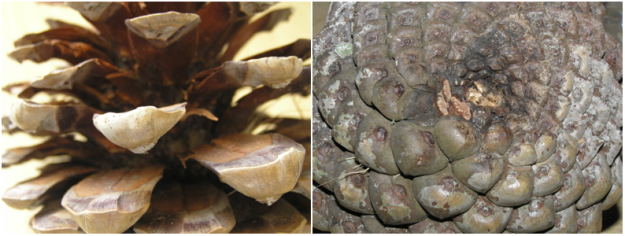









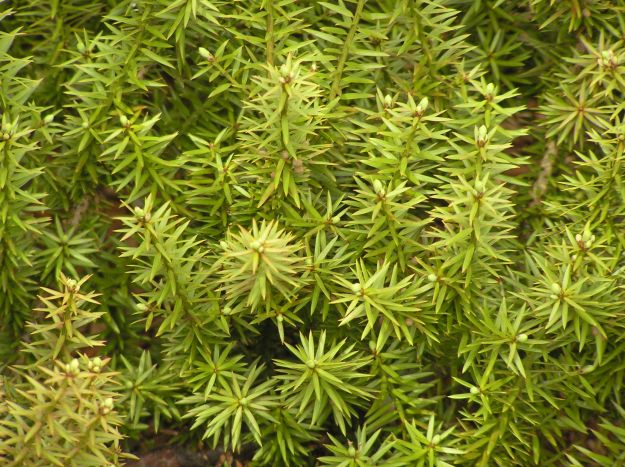





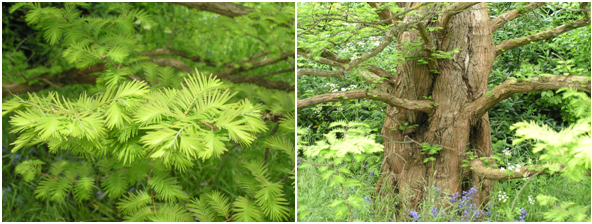
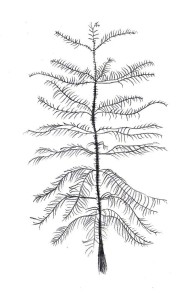
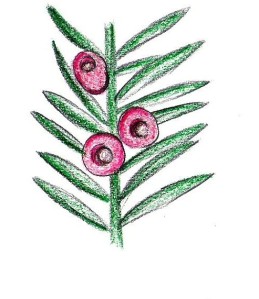


Pingback: RHS Level 3: Plant taxonomy, structure, and function | Tentative Plant Scientist